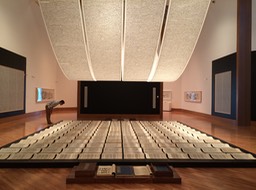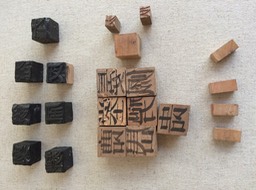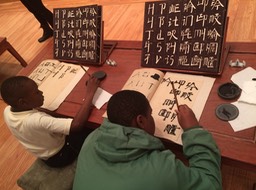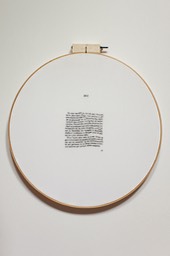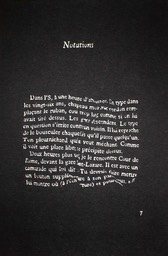Museum director Jordana Pomeroy and guest curator Lidu Yi describe unique features of the exhibition Xu Bing: Writing Between Heaven and Earth and curator Klaudio Rodriguez speaks about the concurrent Monica Bengoa installation.
Connections between words and images feature prominently in exhibitions at FIU’s Frost Art Museum
By George Fishman
With Xu Bing’s Writing Between Heaven and Earth at FIU’s Frost Art Museum, a trio of solo exhibitions featuring contemporary Chinese art giants concludes its 10-month run in a display of silent fireworks. As a bonus, visitors can briefly immerse themselves in the discipline of brush painting, a key to fully engaging the exhibition.
Writing, which encompasses 5,000 square feet, turns the lofty Grand Gallery into a cathedral-like space in which four enormous printed rice-paper scrolls loop “earthward” in parallel arcs above a low square platform (representing Earth) that — like an altar — supports scores of hand-printed volumes, lying open. This powerful yet delicate installation is flanked by large wall-mounted texts also printed with Xu’s invented language. The ambience that the ensemble creates is awesome — in the original sense of the word.
It’s all about language in this show by the 60-year-old Chinese master who survived the Cultural Revolution, lived in New York during the early ’90s (briefly sharing an apartment with Ai Weiwei), received a MacArthur “genius” grant in 1999 and was appointed vice president of the Chinese Academy of Fine Arts in Beijing in 2007.
His fascination with language stems in part from a childhood providence. His mother, a librarian, would leave him in the stacks while she attended meetings. Too young to understand the words, he flipped through the books, eventually developing a fascination with texture, typography, paper and binding — as well as the books’ pictographic characters and literary meaning. This passion has endured and is displayed in spades in this show. As guest curator Dr. Lidu Yi, FIU professor of Asian art, put it, “Even the landscape is actually made of Chinese characters.”
Fascination with the physicality of words is also central to Chilean artist Mónica Bengoa. In her similarly labor-intensive suite of works, the artist manipulates texts by French author Raymond Queneau to create a modestly scaled exhibition that combines penetrating inquiry, obsessive meticulousness and physical grace.
Queneau’s Exercises in Style, written in 1947, consists of a simple anecdote about a dispute on a bus. But, as Frost curator Klaudio Rodriguez explains, the narrator “retells the same story 99 different times and 99 different ways, and in different pitch, in different tone and different form and using made-up words sometimes.” Bengoa is intrigued by connections between form and meaning across mediums and often draws on works by writers who are themselves interested in the act of writing and stylistic experimentation.
Previous large-scale installations have also transformed texts and photographic images into more tangible hand-worked objects, using such materials as dyed thistles and colored napkins. Rodriguez worked with New York-based curator Julia Herzberg in bringing Bengoa to the Frost, where his coordination of scheduling with Xu’s show was fortuitous.
Bengoa’s works vary in scale and materials: embroidery on cotton, cut paper and cut felt. Each involves a multi-step process that begins with tearing out, crumpling, flattening and photographing the first 19 of Queneau’s pages before scaling up, then manipulating the images and “translating” them. A video shows the extraordinarily painstaking processes that retain the illusory undulations of the crumpling process. Says Rodriguez, “It’s almost a form-follows-content idea that any formalistic choice she makes as an artist changes the meaning in some way, whether it's by shape, line, color — whatever she does. And that’s what Queneau does.
“Bengoa is very interested in the simplicity of life: the little things that people forget,” he said. “Very simple, but complex to create and bordering on obsessive.” The “residue” of cut-out letters lies on the floor at the base of the felt works and inside the framed works on paper.
Xu’s process is no less laborious and no less superficially pointless. To create Book from the Sky, which he produced just after graduate school between 1987 and 1991, he invented an alphabet that closely resembles Chinese but has no correspondence to the actual alphabet. “He carved more than 4,000 characters. He invented those characters. Nobody understands a word of it — even the artist himself,” Yi said.
Some of the small wooden blocks are on view, illustrating the typesetting and printing process. Xu has referred to it as a joke, but it’s a serious joke that plays on philosophical assumptions about culture and man’s fundamental search for meaning. On his website, www.xubing.com, the artist wrote that during the 1980s in China there was a “fever” for Western writing and artistic ideas. “We read whatever we could get our hands on, with no order or method whatever.” Eventually, it all became meaningless — at least to him — and so he conceived of the similarly meaningless Book, which his friends initially deemed a “crazy” project. It communicates by not communicating. By inventing a language, he has done alone what thousands of people have historically done interactively, but with the twist that while it appears decipherable to a Chinese speaker, it isn’t. Not even he understands it!
The reverential ambience of the installation suggests the majesty of a redwood forest, or of a supernatural vision, while the four-year production of the work parallels that of manuscript and Torah writing.
Jordana Pomeroy, the new Frost Museum director, took over from Carol Damian in December, “inheriting” her 3 Giants of Chinese Contemporary Art series. Pomeroy had viewed Book from the Sky 14 years ago at the Sackler Gallery in Washington, but in each installation it’s unique.
“In our space it fits perfectly, as though coming down literally from the heavens, like unfurled,” she said, noting that these words — which aren’t really words — carry significant meaning for someone who grew up in a China that was not receptive to free speech. “Also for anyone who grew up in a culture where words have just been used as rhetoric, as in Cuba and other dictatorships where words have been used to keep people in their place.”
Pomeroy shares Professor Yi’s enthusiasm for Chinese art — old and new — so additional Chinese exhibitions will likely follow. “I’ve always felt there’s this connectivity in art history that I learned over time as a curator thinking about 16th century Renaissance to 20th century design,” Pomeroy said, adding that she hopes mounting a wide-ranging landscape exhibition, for example, might provide a visitor the historical context to say, “Now I understand a little bit of what I’ve seen down at Basel.” A recent show connected FIU biologists’ study of microscopic diatoms with watercolor renderings by local botanical artists. “Objects that you see here speak to different historical eras and they have a dialogue across time or across cultures,” Pomeroy said.
Although he is innovator and even an iconoclast, respect for China’s indigenous heritage is certainly part of Xu’s attitude — as it was in the exhibitions of “giants” Simon Ma and Wang Qingsong. Xu explores language from a different angle in the Square Word Calligraphy Classroom. Here, he has invented another language form by arranging English words to resemble Chinese pictographic characters. Initially baffling, close scrutiny of his “workbooks” provides an Aha! experience, as viewers decode words and phrases in the hand-printed books the artist has set out for close examination.
Additionally, visitors can participate in hands-on workshops, using the ink, brushes, copybooks and custom-designed writing desks on offer. These immersive activities allow audiences, as Yi says, “to complete the artwork.”
Artistic brush painting and calligraphy are intertwined because of the pictographic nature of many Chinese characters, the use of the brush in forming them and the traditional incorporation of inscriptions within the painting itself — often by the artist or her scholarly friends. Yi noted that such inscriptions may offer a comment on the artwork’s provenance or the mood of the friend. They may commemorate an event — something like Facebook comments.
Audience participation is also central to the Book from the Ground, an interactive, computer-based artwork that allows visitors to see words translated into the ubiquitous signs and symbols of steaming coffee, airplanes, frowny faces, bar graphs, road signs and the like. It stems from Xu’s wish for a universal language, even if it doesn’t fully achieve that.
Two more works, Landscape/Landscript and Mustard Seed Garden Landscape Scroll, continue explorations of the interconnections between language, nature and the traditions of painting and writing. Mustard Seed is based on an instructional manual from 1679 and re-interprets its original purpose as a teaching method for painting trees, rocks and people. Here it takes the form of a large woodblock print, mounted as a scroll.
In Landscape/Landscript, Xu intuitively uses Chinese characters to form the pictorial elements of his painting. “From a distance, they look like landscape, but they are made of Chinese characters,” said Yi. The overall shape of a mountain, for example, takes its form from the pictographic character “mountain.” Similarly, the grass of a thatched roof looks like the character for grass. Thankfully, the artworks don’t come off as didactic, but rather suggest the mystery of how we decode language and how drawing and painting appear simultaneously as physical marks on a substrate and as representations of an entity or idea. Such conceptual probings have been central to the artist’s long career, in which he has interwoven objects and symbols of traditional China and those of the West.
Whether using silkworms and mulberry plants, ink and paper, construction debris or creating “carpets” of cigarettes, (as he has done in other projects), Xu prods us to question fundamental cultural beliefs. The confluence with Bengoa’s exploration of handwork, repetition and interpretive strategies makes for a profoundly unsettling, but satisfying visit.
Listen to curatorial commentary: bitly.com/CuratorsFIU
IF YOU GO
What: ‘Xu Bing: Writing Between Heaven and Earth’
When: Through May 24
Where: The Patricia & Phillip Frost Art Museum, Florida International University, 10975 SW 17th St., Miami
Info: http://thefrost.fiu.edu/artinfo@fiu.edu,
305-348-2890, closed Mondays; free admission
What: ‘Mónica Bengoa: Exercices de Style / Exercises in Style’
When: Through April 26
